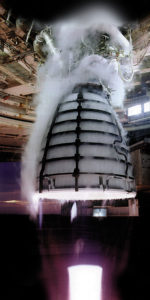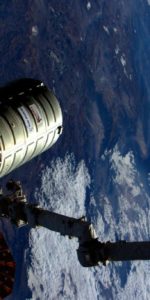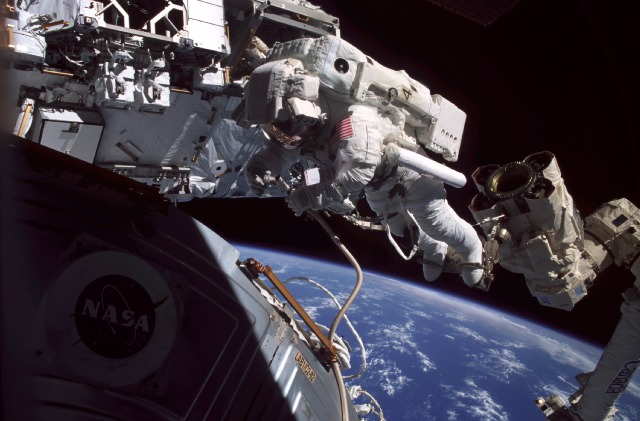
Fifteen years ago, on the morning of 8 April 2002, U.S. astronaut Jerry Ross—veteran of seven space missions and seven spacewalks—settled into orbit aboard shuttle Atlantis, having just launched from Earth more times than any other human being. Ross had previously held the record for the greatest number of previous spaceflights at six, jointly shared with Story Musgrave, Franklin Chang-Diaz and Curt Brown, as well as John Young. Yet on his record-breaking seventh mission into low-Earth orbit, Ross would continue to break records, raising his number of Extravehicular Activities (EVAs) to nine and securing himself as the most experienced U.S. spacewalker at that time. Even today, he sits in third place on the list of the world’s most seasoned spacewalkers.
And although his U.S. EVA record has long since been broken, and his flight record was later equaled by Chang-Diaz, the accomplishment of launching seven times from Earth into space has never been beaten. By Ross’ own admission, though, his personal hero is Gemini, Apollo and shuttle veteran John Young, who launched six times from Earth and once from the Moon during his career. Writing in his memoir Spacewalker, Ross recalled that he never set out to eclipse Young’s record. “I wanted to fly again,” he explained. “In my heart, I was an astronaut and a spacewalker and there was an International Space Station to assemble. I wanted to continue doing what I loved.”
Having led the EVA team on STS-88, the first ISS construction mission, in December 1998, it might be supposed that Ross would have had the edge on selection to a future crew. However, with a significant number of unflown members of the Astronaut Office by early 2001, he was keenly aware that his age and experience might work against him. In Spacewalker, he remembered checking with Chief Astronaut Charlie Precourt to ascertain if a “glass ceiling” existed. Could he fly more than six times? Precourt replied that no such ceiling existed and in April 2001 he was formally announced as a member of the STS-110 crew, scheduled for launch in January of the following year.
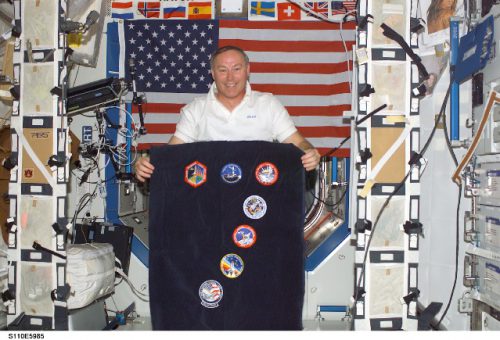
Joining Ross were fellow spacewalkers Steve Smith—an veteran astronaut, having performed five EVAs to service and upgrade the Hubble Space Telescope (HST)—and “rookies” Lee Morin and Rex Walheim. They would work in alternating teams to execute four complex spacewalks, with Smith and Walheim performing EVAs 1 and 3 and Ross and Morin handling EVAs 2 and 4. Since both Ross and Morin were grandfathers at the time of STS-110, they were nicknamed the “Silver Team” by their crewmates. In Spacewalker, Ross noted that the nickname came about because of their hair color, but acquiesced that “it sounded a lot better than the Gray Team or the Balding Team”.
This was only the third shuttle crew to include as many as four spacewalkers for ISS assembly. As such, the astronauts’ Extravehicular Mobility Units (EMUs) were specially marked for identification. As EV1, Smith carried red stripes on the legs of his suit, whilst Walheim (EV2) wore a pure white suit. Jerry Ross, as EV3, had broken red stripes on the legs of his suit and Morin boasted red-and-white diagonal hatches.
Rounding out the seven-member crew were Commander Mike Bloomfield, Pilot Steve Frick and Flight Engineer Ellen Ochoa, the latter of whom would go on to serve as the first Hispanic and the second female director of the Johnson Space Center (JSC) in Houston, Texas. With Bloomfield making his third shuttle flight, Ross his seventh and Ochoa and Smith their fourth, STS-110 boasted an ample mix of experience to support first-time flyers Frick, Morin and Walheim. In fact, during training, Walheim often joked that he and Ross had six previous spaceflights between them.
“I’ve got just the right mix of experience and inexperience,” Bloomfield told a NASA interviewerer, before the flight. “The inexperience is neat, because the new guys, the rookies—because they bring all the excitement to the flight and…all the questions—it’s going to be neat to see their faces when we finally get into space and begin the mission. Having three experienced guys and three inexperienced guys, you can team ’em up real easily, and so I can let the experienced guys help out the inexperienced guys as we get ready to train, and when we get up on-orbit that’s kind of the way we’re going to operate as well.”
For the rookies, having experienced crewmates enabled them to understand the enormity of the mission. “Mike Bloomfield and Ellen Ochoa keep reinforcing to us that it’s going to be like nothing we’ve ever seen when you see the actual station out there,” said Frick in a pre-flight interview. “We have great simulators and we have a good idea of how the shuttle’s going to fly and what we have to do to get it safely docked. But when…you look out the window and see that huge station looming up, it’s going to really be exciting!”
As significant as Ross’ work on STS-88 had been, his EVAs on STS-110 would be equally pivotal, for the mission was tasked with delivering, installing and activating the central core segment of the station’s Integrated Truss Structure (ITS). When fully assembled, the 356-foot-long (108.5-meter) structure would support four gigantic pairs of electricity-generating Solar Array Wings (SAWs), together with radiators, storage batteries and other subsystems. Designated “ISS Assembly Flight 8A”, the crew of STS-110 would install the central core segment—designated “S-0”—onto a mounting location atop the U.S. Destiny lab. The S-0 truss was built by Boeing and measured approximately 44 feet (13.4 meters) long by 15 feet (4.5 meters) wide, tipping the scales at around 27,000 pounds (12,250 kg).
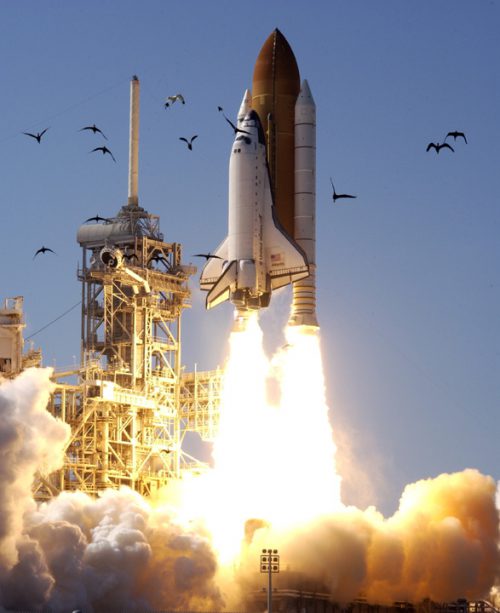
In function, S-0 would serve not only as a structural backbone for the rest of the ITS, but was also intended to facilitate power conversion and routing to downstream electrical loads and act as a junction through which external utilities could be routed to the station’s pressurized modules. In the words of Lee Morin, it was literally the “crossroads” of the station, interfacing with its power-generating extremities and its pressurized modules. It provided mounting locations for electronics, as well as four Global Positioning System (GPS) antennas, a pair of rate gyros and—on its aft face—a 21-foot (6.4-meter) radiator. Meanwhile, on its forward face, S-0 carried the rails of a track which would eventually allow equipment to be moved, via the Mobile Transporter, to the farthest reaches of the ITS.
Launch was originally targeted for 4 April 2002, but was postponed by four days, when a hydrogen leak was detected in the Mobile Launch Platform (MLP). “We busied ourselves marking time at the [KSC] Beach House, running, riding bikes, watching movies and studying,” Ross explained in Spacewalker. “My family left me behind and went to Disney World.” At length, launch was rescheduled for 8 April.
“Setting in place the keystone to the Space Station’s backbone,” intoned the Kennedy Space Center (KSC) announcer, as Atlantis speared away from Pad 39B at 4:44 p.m. EST on 8 April 2002. Liftoff occurred only 12 seconds before the closure of that day’s five-minute “window”, following a brief—albeit significant—delay, triggered by a ground software glitch in the Launch Control Center (LCC). Seated side-by-side on the middeck, Ross and Smith gave each other high-fives as the shuttle left Earth. Within nine minutes, Atlantis settled into orbit for the 25th time in her spacegoing career. Before STS-110, she had supported five Department of Defense missions, had launched two planetary probes and one of NASA’s Great Observatories, had staged all but two of the nine shuttle-Mir docking flights and had voyaged four times to the ISS. And on STS-110, Jerry Ross became her most-flown crew member. Out of his seven shuttle missions, five of them were flown aboard Atlantis.
Significantly, STS-110 was also the first time that all three Space Shuttle Main Engines (SSMEs) were of the “Block II” variety. One of these upgraded engines had flown aboard Atlantis on her previous mission, STS-104 in July 2001, with the other two engines belonging to an older design. The Block IIs boasted a new Pratt & Whitney high-pressure fuel turbopump and eliminated many welds by using a casting process for the engine housitng. This built on previous upgrades and—despite a 300-pound (135 kg) weight penalty—served to effectively double the reliability and safety of the SSMEs.
During their two-day chase of the space station, the seven astronauts tested and prepared the shuttle’s systems for rendezvous. They also checked out the four EMUs for the spacewalks and tested Atlantis’ Remote Manipulator System (RMS) mechanical arm. The final stages of rendezvous on the third day of the mission, 10 April, involved all seven astronauts: Bloomfield at the aft flight deck windows, with Frick handling the maneuvering “burns” from the Commander’s seat, Walheim operating the laser rangefinder, Ochoa and Ross supervising the docking mechanism . Atlantis followed a customary rendezvous profile, approaching the ISS from “below” and flying around the front of the station to effect a docking at the forward end.
At 12:05 p.m. EST on 10 April, Bloomfield gently guided his ship to a smooth docking at Pressurized Mating Adapter (PMA)-2, on the forward end of the U.S. Destiny lab. At the time of docking, the ISS and the shuttle were flying about 240 miles (386 km) above south-central China, to the southwest of Shanghai. Aboard the station, Expedition 4 Commander Yuri Onufrienko of Russia and his NASA crewmates, Carl Walz and Dan Bursch, were ready to welcome their first human visitors since arriving aboard the ISS in December 2001. Bursch, a U.S. Navy captain, traditionally rang the ship’s bell to welcome Atlantis. And about two hours later, at 2:07 p.m., hatches were opened and the ten astronauts and cosmonauts greeted each other.
Following a safety briefing by Onufrienko, they set to work. Ahead lay four challenging EVAs and one of the largest pieces of hardware ever installed aboard the space station. And simply installing it and getting it operational would require four pairs of human arms and a pair of robotic arms, to say nothing of thousands of personnel on the ground.
The second part of this article will appear tomorrow.
Be sure to “LIKE” AmericaSpace on Facebook and follow us on Instagram & Twitter!




